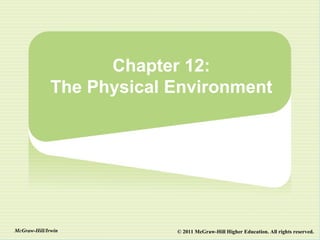
Infants, Toddlers & Caregivers Ch 12
- 1. Chapter 12: The Physical Environment McGraw-Hill/Irwin © 2011 McGraw-Hill Higher Education. All rights reserved.
- 2. A Safe Environment • The physical environment must be safe. – Group size and adult-child ratio are important. – Child-proof the environment. – Know how to contact emergency personnel and put together an emergency plan. – Know first aid and CPR. – Always supervise children. 12-2
- 3. A Healthful Environment • The environment must be healthy. – Wash your hands often. – Make sure there is good light and ventilation. – Wash children’s hands regularly. – Use precautions when preparing food, changing diapers, etc. – Learn signs of common illness and follow polices about reporting illness. 12-3
- 4. Nutrition • Food must be appropriate to: – Children’s age – Children’s physical condition – Children’s cultural and/or religious traditions 12-4
- 5. Nutrition • Feeding infants: – Make sure the room is supportive of breast-feeding mothers. – Learn how to properly handle and store breast milk. – Provide for individualized infant nutrition. 12-5
- 6. Nutrition • Feeding infants: – Avoid additives – Avoid mixtures (casseroles, etc.) – Use pure, unseasoned food – Talk with parents about special dietary needs 12-6
- 7. Nutrition • Feeding toddlers: – Offer a nutritious variety of foods – Incorporate finger foods if culturally appropriate – Use small portions – Avoid foods which may choke toddlers 12-7
- 8. The Learning Environment • The structure of a program depends on its environment. – Behavior is influenced by environment. – All children should be accommodated in the environment. 12-8
- 9. The Learning Environment • Layout – The sleeping area should be away from the play area. – The eating area should be away from the diapering area. – If possible, keep the eating area away from the play area. 12-9
- 10. The Learning Environment • Eating area – A sink, counter, refrigerator, and provision for warming food should be either in the room or near the eating area. – Children need small, low tables to encourage independence. How do you feel about eating outdoors? 12-10
- 11. The Learning Environment • Toileting area – Toddlers appreciate child-sized toilets. – Children need access to a sink, soap, and towels. – The toileting area should be convenient to play space. 12-11
- 12. Developmental Appropriateness • The learning area must be developmentally appropriate. • Flexibility is required when infants and toddlers are in the same room. 12-12
- 13. Developmental Appropriateness • An appropriate environment for infants: – Allows infants to be on the floor, but protected from walking feet – Has supports for infants who are newly upright – Only uses cribs as sleeping environments 12-13
- 14. Developmental Appropriateness • An appropriate environment for toddlers: – Is an environment that encourages independence – Invites toddlers to explore using both gross and fine motor skills – Contains a variety of age-appropriate toys and equipment that develop active, creative, and manipulative skills 12-14
- 15. Developmental Appropriateness • Family child care: – May have a less “institutionalized” feel – May be smaller in scale and more homey – Is more likely to have mixed age groups, and must adapt the space to promote safe interactions and exploration for infants and toddlers 12-15
- 16. What should be in the play environment • Newborns: – Just a few things to look at. People are most interesting. • Young infants: – Should not be distracted from hand exploration. – Multi-sensory toys not necessary. – 14 x 14 cotton scarf multi-purpose infant toy. • Older infants: – Bowls, wooden spoons, stackable plastic cups. 12-16
- 17. What should be in the play environment • Simple play materials, individualized attention, and a safe environment that promotes interaction are essential components to infant and toddler play. – Such conditions help children develop long attention spans, concentration, and other manipulative and physical skills. 12-17
- 18. What should be in the play environment What toys and materials are appropriate for inside play? What toys and materials are appropriate for outside play? 12-18
- 19. Assessing the Quality of an Infant-Toddler Environment • The five dimensions of a learning environment include: – Balancing soft and hard – Providing for intrusion and seclusion – Encouraging mobility – The open-closed dimension – The simple-complex dimension 12-19
- 20. Assessing the Quality of an Infant-Toddler Environment • Simple toys and materials are best for infants. • Children under age three may need more open- ended materials than closed ones. What types of toys are open-ended? 12-20
- 21. Assessing the Quality of an Infant-Toddler Environment • The following characteristics are also important: – Aesthetics (the visual appeal of the room) – Acoustics (are children who need quiet protected?) – Order (room arrangement can make a big difference in the order of a room) 12-21
- 22. The Physical Environment • Remember, when planning a physical environment, be sure to consider: – Developmentally appropriate practice – Individually appropriate practice – Culturally appropriate practice 12-22
- 23. Online Learning Center • See Chapter 12 of the text’s Online Learning Center for chapter quizzes, Theory Into Action activities, Video Observations, and more. 12-23
